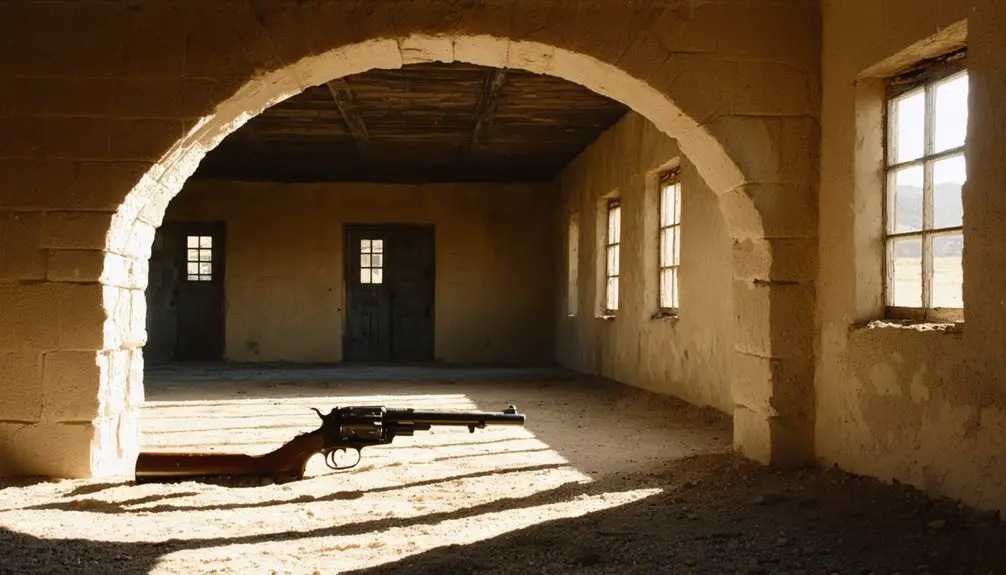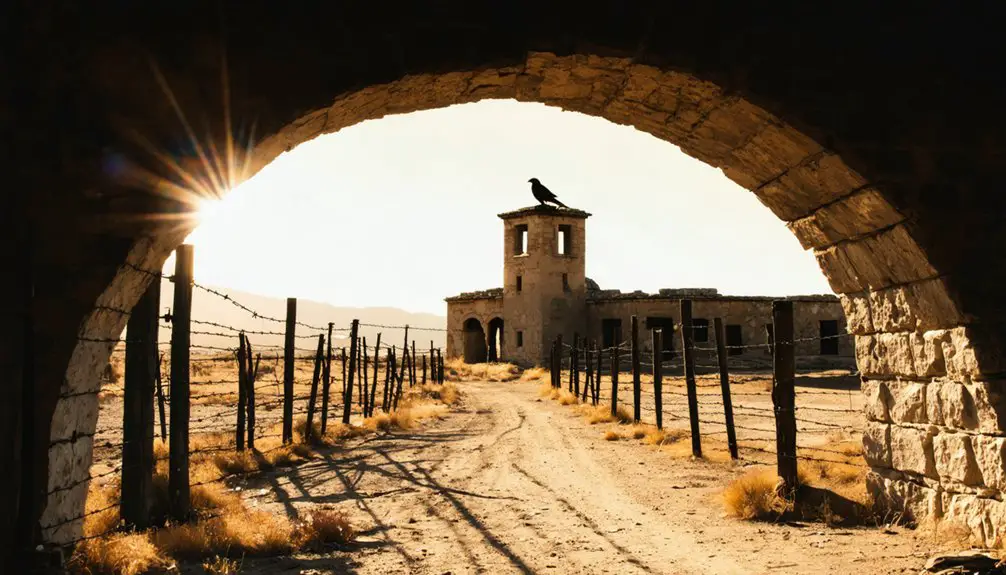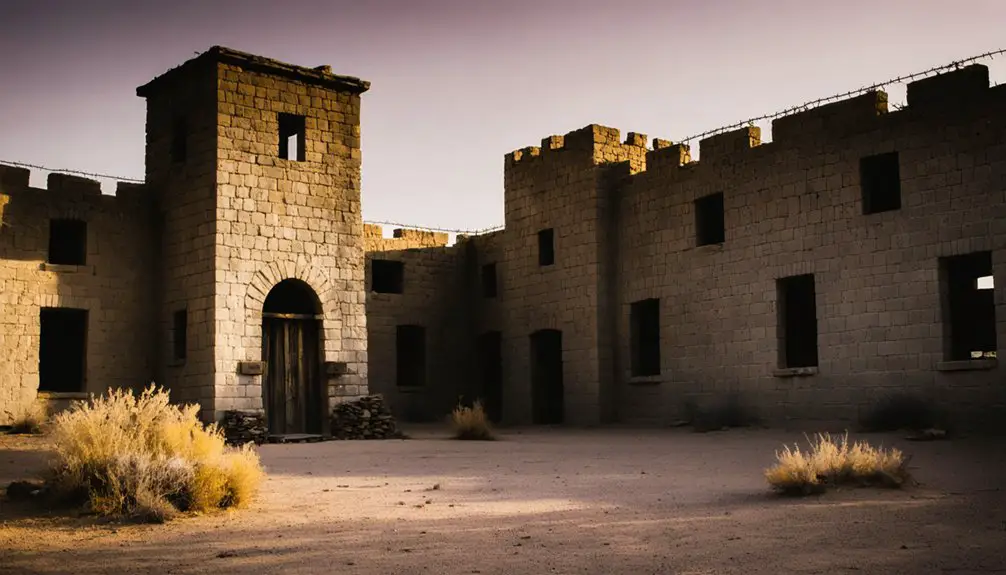At Fort Stanton in New Mexico, you’ll discover a compelling frontier outpost that evolved from a military stronghold to a tuberculosis hospital while accumulating layers of haunting history. Built in 1855 using local sandstone, the fort witnessed Apache wars, Civil War conflicts, and served as a WWII internment facility. Today, its 88 surviving buildings tell tales of shadowy figures, mysterious voices, and unexplained phenomena that echo through its storied halls.
Key Takeaways
- Built in 1855 using local sandstone, Fort Stanton served as a military stronghold during brutal conflicts with Mescalero Apache tribes.
- The fort witnessed intense violence during the Civil War, with multiple burnings and deadly shootouts between Union and Confederate forces.
- Over 5,000 tuberculosis patients were treated at Fort Stanton between 1899-1953, making it America’s first federal tuberculosis sanatorium.
- During WWII, the fort transformed into an internment camp for German merchant seamen and briefly housed threatened Japanese-American families.
- Paranormal investigators report unexplained phenomena including mysterious voices, shadowy figures, and temperature fluctuations throughout the fort’s buildings.
The Strategic Birth of a Military Stronghold
What began as a proposed trading post through indigenous relations with Mescalero leader Josecito transformed into a military strategy of conquest.
Three hundred soldiers from the 3rd U.S. Infantry Regiment constructed the fort using local sandstone, defying orders to build with adobe. This decision proved essential, as Fort Stanton’s unique stone architecture enabled it to withstand decades of service through multiple conflicts, including the Civil War and Indian Wars. The fort’s remarkable durability was demonstrated as it survived multiple burnings during the Civil War period.
The fort’s remote location over one hundred miles from major settlements created significant challenges in accessing skilled craftsmen and resources.
Blood-Soaked Ground: Apache Wars and Resistance
When you stand at Fort Stanton today, you’re witnessing ground where the Mescalero Apache people, who called this beautiful land zúuníidu, began their desperate resistance against military occupation in 1855.
You’ll find evidence of intense military campaigns led by figures like Kit Carson, who systematically destroyed Apache communities through scorched-earth tactics and forced relocations to Bosque Redondo. After being destroyed in Union abandonment, the fort was rebuilt to continue its mission of controlling the Apache people.
The fort’s sandstone walls mark the tragic transformation of ancestral Mescalero territory into a military stronghold that permanently altered the region’s indigenous landscape. The fort’s Buffalo Soldiers would later play a crucial role in rounding up Apache who had fled from reservations.
Apache Resistance Begins Here
As Fort Stanton rose from the heart of Mescalero Apache territory in 1855, it marked the beginning of an intense period of armed resistance and bloodshed.
What began with Josecito’s proposal for peaceful trade devolved into a symbol of military occupation when the U.S. Army constructed the fort in zúuníidu, the “beautiful land” the Apache had called home since the 16th century.
You’ll find that the Apache resistance wasn’t merely a reaction to the fort’s presence but a demonstration of cultural resilience.
Their strategic raids targeted settlements and military outposts along the Rio Bonito, reclaiming livestock, weapons, and ancestral territories.
When Union forces abandoned the fort in 1861, the Mescalero Apache seized the opportunity to intensify their campaign, reasserting control over central New Mexico’s contested landscape.
The fort’s namesake, Captain Henry W. Stanton, met his fate when he was killed by Mescaleros during a clash in 1855.
These raids continued well into 1885, when Apache forces under Geronimo’s leadership maintained their fierce resistance against military pursuit.
Military Campaigns Against Natives
The blood-soaked grounds of Fort Stanton bear witness to some of the most brutal military campaigns against Native Americans in the Southwest.
Under Kit Carson’s command, the New Mexico Volunteers launched systematic operations to suppress Apache resistance, employing devastating military strategy that targeted the foundations of Native life.
You’ll find these stark realities of the campaigns’ impact:
- Union forces destroyed Apache fields, orchards, and settlements to weaken their ability to resist.
- Apache tactics of disrupting supply lines proved effective but ultimately couldn’t halt the overwhelming military pressure.
- The campaigns culminated in forced relocations to Bosque Redondo, where many Natives faced severe hardship.
Built by the 1st Dragoon Regiment in 1855, this military outpost became a central base for conducting relentless campaigns against the Mescalero Apache.
From this strategic outpost, U.S. forces methodically dismantled Apache sovereignty through calculated military operations, forever altering the cultural landscape of the American Southwest.
Mescalero Territory Lost Forever
Military conquest of Apache lands tells only part of Fort Stanton‘s tragic story.
You’ll find the deeper narrative in the Mescalero Apache‘s profound connection to zúuníidu – their “beautiful land” – and its devastating loss.
Before the fort’s 1855 construction, this valley between the Capitán Mountains and Sierra Blanca served as their ancestral lands for generations.
Fort Stanton’s establishment marked the beginning of systematic dispossession.
You can trace how military campaigns destroyed Mescalero homes, fields, and orchards, while forcing them onto reservations. Captain Henry W. Stanton died fighting these fierce Apache warriors, lending his name to the fort that would help destroy their way of life.
Though they repeatedly escaped and returned home, showing remarkable resistance to protect their cultural heritage, the Apache Wars ultimately severed their territorial sovereignty.
The blood-soaked ground beneath Fort Stanton stands as a memorial to the Mescalero people’s loss of their sacred homeland forever.
Civil War Drama: A Fort Divided
You’ll discover Fort Stanton‘s tumultuous Civil War period began in 1861 when Confederate forces seized the partially burned fort after Union troops attempted to destroy it during their withdrawal.
Located along the Billy the Kid Byway, the historic fort stands as a testament to the military conflicts that shaped the American Southwest.
The fort’s strategic importance led to a cycle of occupation and abandonment, with Confederate forces later torching supplies during their own retreat, leaving it empty for nearly a year until Union reoccupation in 1862.
Your understanding of this chaotic period wouldn’t be complete without knowing about the deadly 1862 shootout between Captain Paddy Graydon and Dr. John Whitlock, which ended in both men’s deaths and highlighted the intense internal conflicts that plagued the fort during wartime.
Three Rebels were killed by Kiowa Indians while patrolling the area during the Confederate occupation, demonstrating the ongoing dangers faced by soldiers at the remote outpost.
Confederate Occupation and Escape
During the tumultuous early phase of the Civil War in 1861, Confederate forces seized Fort Stanton, recognizing its strategic value along the Rio Bonito and its position guarding Mescalero Apache territory in the Capitan Mountains.
You’ll find that Confederate tactics at Fort Stanton were severely challenged by the harsh realities of frontier warfare. Their occupation faced constant disruption from Native American raids, with Kiowa warriors killing three Confederate soldiers during a patrol.
When defeat loomed in 1862 after the Battle of Glorieta Pass, the Confederates implemented three dramatic final measures:
- Stripped the fort of all valuable supplies
- Set fire to the fort’s buildings in a scorched earth strategy
- Retreated southward, leaving the smoldering ruins to be saved only by fortuitous heavy rains
Shootout Between Union Officers
As tensions escalated in the post-Civil War frontier, Fort Stanton became the epicenter of a violent shootout between Union officers that would later intertwine with the infamous Lincoln County War.
At the heart of these Union conflicts, Captain Paddy Graydon found himself embroiled in factional disputes that reflected the broader instability of New Mexico’s territorial period.
You’ll find that frontier justice took a complex turn as the Murphy-Dolan faction, backed by Sheriff Brady, clashed with the Tunstall-McSween group.
The fort’s Buffalo Soldiers of the 9th Cavalry became instrumental in maintaining order, with Colonel Nathan Dudley’s troops deploying artillery to quell the violence.
The military’s intervention, particularly during the Battle of Lincoln, demonstrated federal authority’s growing role in containing the lawlessness that had gripped the region.
Tales of Tragedy: The Graydon-Whitlock Shootout

The volatile tensions at Fort Stanton erupted into deadly violence on November 5, 1862, when Captain James “Paddy” Graydon and Dr. John Whitlock faced off in a fatal confrontation.
Graydon’s motives stemmed from Whitlock’s criticism of his brutal treatment of Mescalero Apaches, including the controversial killing of Chief Manuelito. When shots rang out on the parade grounds, both men suffered wounds, but Whitlock’s fate proved particularly tragic.
Whitlock’s outspoken criticism of Apache mistreatment sealed his fate when Graydon confronted him on Fort Stanton’s blood-stained grounds.
- Whitlock fled to the sutler’s store while pursued by 30 of Graydon’s men
- Graydon died three days later from a chest wound
- Whitlock’s body, riddled with over 100 shots, left a dark legacy of frontier justice
Colonel Kit Carson’s fury at this event reflected the deep divisions within the fort’s command structure, highlighting the complex tensions between military authority and moral conscience.
From Warriors to Healers: The Tuberculosis Hospital Years
Converting from military outpost to medical sanctuary, Fort Stanton underwent a remarkable transformation in 1899 when President William McKinley designated it America’s first federal tuberculosis sanatorium.
You’ll find that over 5,000 patients, primarily Merchant Marines and Coast Guard sailors, sought healing in the fort’s high desert climate between 1899 and 1953.
The facility pioneered innovative patient care through its self-sufficient approach, featuring tent-houses, recreational facilities, and a working farm.
During the New Deal era, modern amenities emerged, including New Mexico’s first electrical elevator.
The economic impact rippled throughout the region, as Fort Stanton’s presence sparked the creation of 68 other sanatoriums and transformed New Mexico into a haven for health-seekers, who ultimately comprised 10% of the state’s population.
Hidden Stories of World War II Internment

While Fort Stanton’s healing mission continued into the 1940s, a dramatic shift occurred when the facility began housing German merchant seamen from the scuttled S.S. Columbus.
These hidden narratives of internment experiences reveal both the complexities of wartime security and human resilience. You’ll discover how the camp transformed from a relatively open facility to a fortified compound after Germany’s declaration of war against the U.S.
- Initially, internees enjoyed considerable freedom, building gardens, a recreation hall, and even hosting “Mini-Olympics” in their self-constructed swimming pool.
- Following December 1941, armed guards, watchtowers, and floodlights turned Fort Stanton into a secure internment facility.
- The camp briefly served as a refuge for threatened Japanese-American families, though their presence alongside German POWs created unprecedented tensions requiring their relocation.
Architectural Legacy: 88 Buildings Frozen in Time
Standing as a representation of frontier military architecture, Fort Stanton‘s 88 buildings across 240 acres showcase an exceptional departure from traditional Southwestern construction methods. Unlike the adobe structures common to the region, you’ll find buildings crafted from locally quarried sandstone, lending them remarkable durability through 170 years of transformation.
The fort’s architectural preservation reveals layers of American history, from its military origins to its roles as a tuberculosis hospital, internment camp, and correctional facility.
Six of the original nine 1855 buildings still stand, maintaining their historical significance alongside the parade ground. While many structures now face disrepair, their robust sandstone construction has defied time, making Fort Stanton the most intact Territorial-era fort in the Southwest, where each building tells a story of adaptation and survival.
Echoes of the Past: Unexplained Phenomena and Hauntings
Beyond its architectural grandeur, Fort Stanton harbors a darker legacy of unexplained phenomena that dates back to the 1940s.
Beneath Fort Stanton’s majestic walls lies a sinister history of paranormal activity stretching back generations.
You’ll encounter haunted echoes of its complex past as a military outpost, tuberculosis hospital, and WWII internment camp. The thousands who perished here have left an indelible mark, with spectral sightings reported by staff and visitors alike.
- Mysterious voices and unexplained sounds reverberate through abandoned halls, while objects move without explanation.
- Temperature fluctuations and shadowy figures appear during paranormal investigations, documented by professional ghost hunting teams.
- The remote location amplifies the eerie atmosphere, especially along the main road where over 50 violent deaths occurred between 1870 and 1886.
These supernatural occurrences have transformed Fort Stanton into a focal point for those seeking to unveil the mysteries of the afterlife.
Frequently Asked Questions
What Happened to Fort Stanton’s Original Native American Artifacts and Weaponry?
You won’t find Fort Stanton’s original Native American artifacts there today – military campaigns, relocations, and poor artifact preservation practices led to their loss or destruction, though some cultural items remain with Mescalero Apache tribes.
How Many Soldiers and Civilians Died at Fort Stanton During Its Operation?
You’ll find soldier casualties aren’t precisely documented, though many died in Apache conflicts. Civilian impacts were severe, with particularly high death tolls during the TB sanatorium era and 61 deaths during WWII.
Are Guided Ghost Tours or Paranormal Investigations Allowed at Fort Stanton?
A million ghostly encounters await! You can join authorized ghost hunting and historical tours at Fort Stanton during special “After Dark” events, but you’ll need to book through official channels.
What Were the Daily Routines and Living Conditions for Buffalo Soldiers?
You’d find Buffalo Soldiers performing daily patrols, protecting settlers, maintaining fort structures, and enduring harsh frontier conditions while building strong community bonds despite institutional racism and extreme isolation.
Can Visitors Stay Overnight in Any of Fort Stanton’s Historic Buildings?
While you might dream of sleeping where soldiers once stood, you can’t stay overnight at Fort Stanton. Historic preservation efforts mean the buildings remain strictly for daytime tours and education.
References
- https://nmhistoricsites.org/fort-stanton/history
- https://www.museumfoundation.org/historic-sites/fort-stanton-historic-site/
- https://kids.kiddle.co/Fort_Stanton
- https://www.battlefields.org/visit/heritage-sites/fort-stanton
- https://www.fortstanton.org
- https://elpalacio.org/2024/03/historic-site-conversations/
- https://www.fortstanton.org/the-military-years
- https://www.fortstanton.org/history
- https://www.legendsofamerica.com/nm-fortstanton/
- https://www.newmexicomagazine.org/blog/post/new-mexico-history-fort-stanton/



